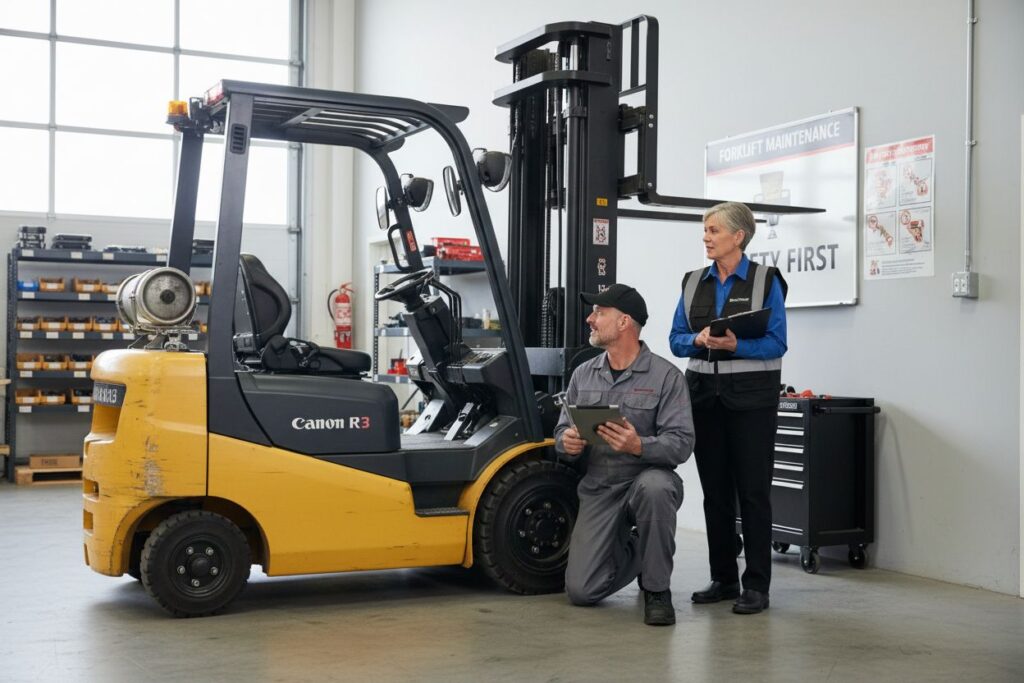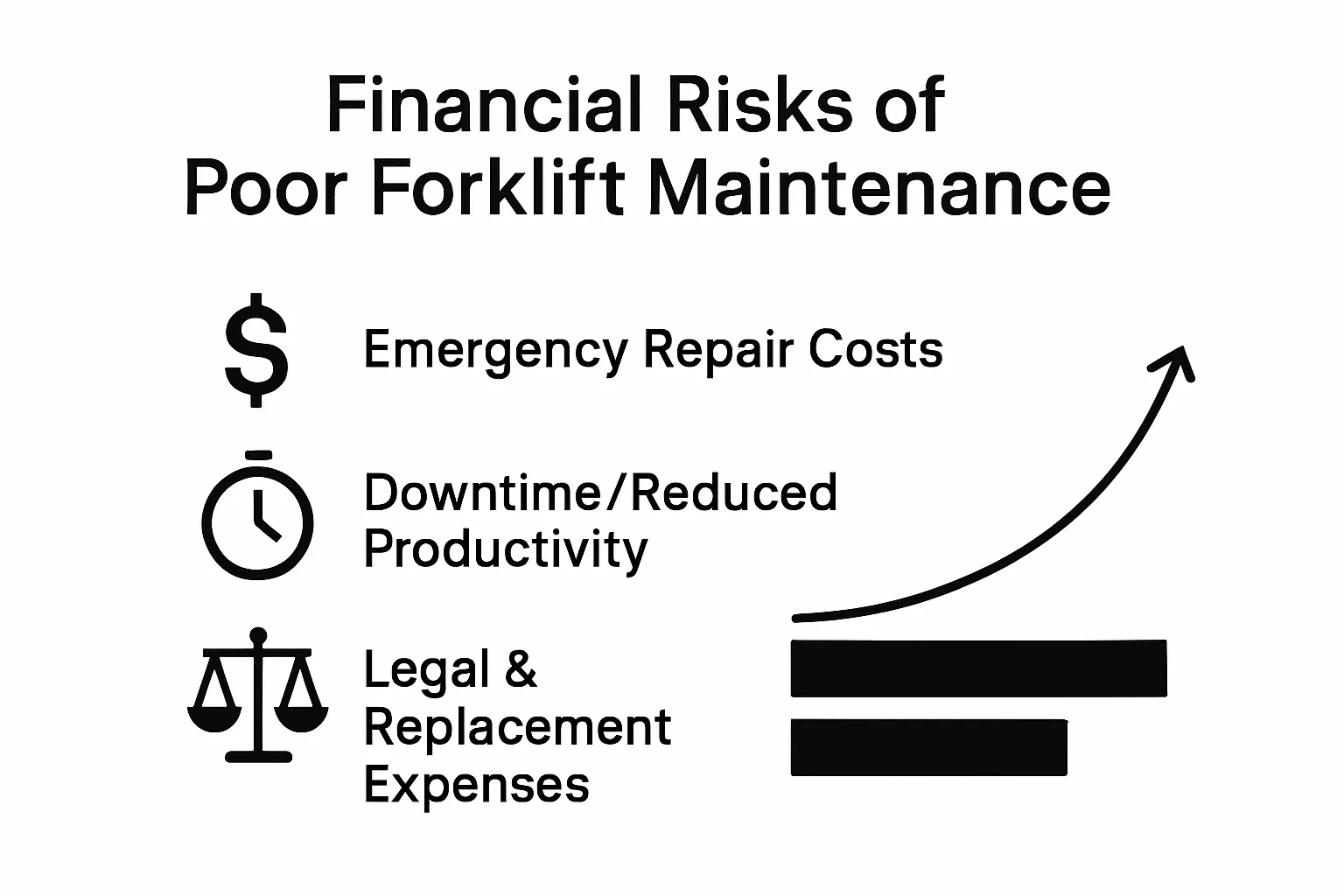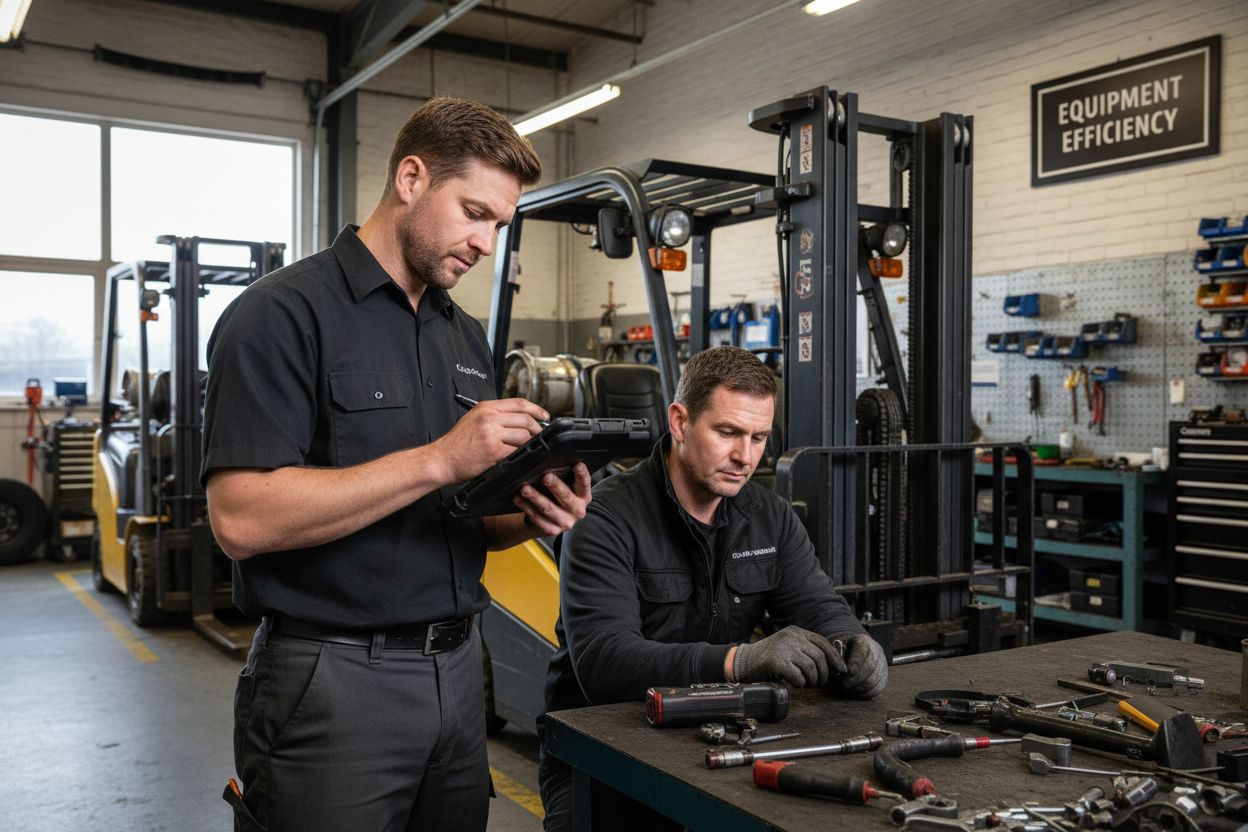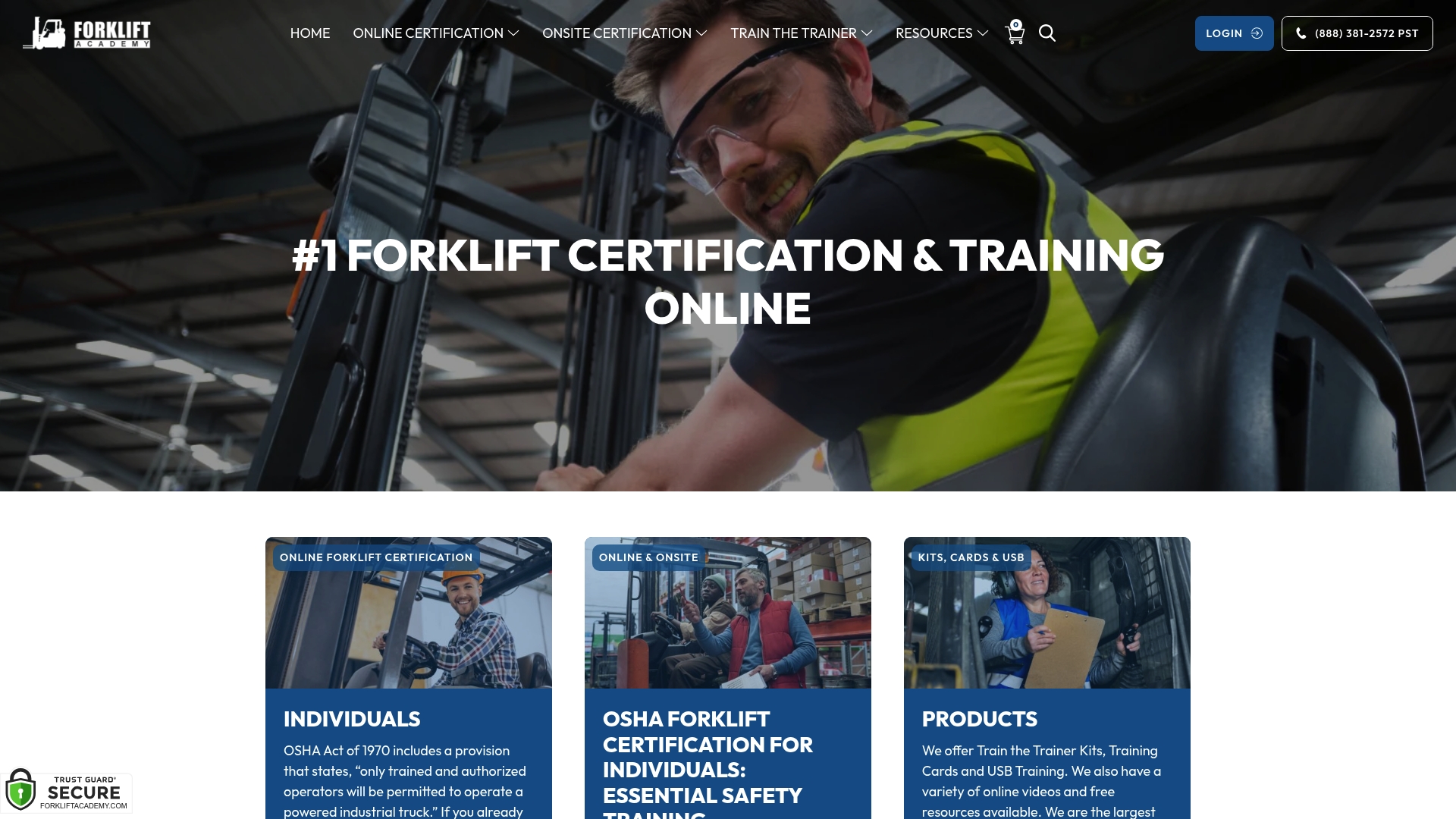
Forklifts move almost everything inside warehouses and factories yet their real impact often goes unnoticed. Most people are surprised to learn that keeping up with regular forklift maintenance is legally required by OSHA for every business using industrial lifting equipment. The real shocker is how poor maintenance can drain company profits and put lives at risk faster than any other equipment oversight.
| Takeaway | Explanation |
|---|---|
| Routine maintenance prevents failures | Regular checks help detect issues early, ensuring forklift functionality and safety. |
| Maintenance ensures workplace safety | Systematic equipment care mitigates risks and prevents accidents, protecting workers. |
| Neglect leads to higher costs | Poor maintenance results in emergency repairs, downtime, and increased operational expenses. |
| Documentation is essential | Keeping detailed records of maintenance activities ensures compliance and operational accountability. |
| Proactive strategies enhance performance | Advanced diagnostics and routine care optimize equipment reliability and minimize unexpected breakdowns. |
Forklift maintenance is a systematic approach to preserving the operational integrity, safety, and performance of industrial lifting equipment. At its core, maintenance involves regular inspections, preventive services, repairs, and documentation designed to ensure forklifts remain in optimal working condition. Our comprehensive guide to forklift maintenance provides deeper insights into this critical process.
The primary purpose of forklift maintenance extends far beyond simple equipment upkeep. It serves multiple critical functions within industrial and warehouse environments. Maintenance aims to:
Effective forklift maintenance involves several interconnected strategies that work together to protect both equipment and personnel. These strategies typically include routine mechanical assessments, comprehensive safety checks, lubrication procedures, component replacements, and thorough documentation of all maintenance activities.
According to Occupational Safety and Health Administration (OSHA) guidelines, regular maintenance is not just recommended but legally mandated for businesses using industrial lifting equipment. This means companies must implement structured maintenance protocols that systematically address potential mechanical and operational risks.
By understanding and implementing robust maintenance practices, organizations can significantly reduce the likelihood of equipment failures, workplace accidents, and costly operational disruptions. The investment in consistent, proactive maintenance ultimately translates to enhanced safety, improved equipment reliability, and long-term cost savings.
Forklift maintenance transcends routine equipment care and represents a critical safety intervention in industrial workplaces. By systematically addressing potential mechanical vulnerabilities, maintenance directly prevents accidents, protects workers, and ensures operational reliability. Check out our essential forklift maintenance checklist to understand comprehensive safety protocols.
Mechanical failures in forklifts can lead to catastrophic workplace incidents. Critical components like brakes, steering mechanisms, and hydraulic systems must be meticulously monitored and serviced. Potential risks include:
Regular maintenance serves as a proactive risk management strategy. According to Occupational Safety and Health Administration (OSHA) research, unmaintained forklifts dramatically increase workplace injury probabilities. A comprehensive maintenance program systematically identifies and resolves potential mechanical vulnerabilities before they transform into dangerous operational scenarios.
Proper maintenance involves more than mechanical inspections. It encompasses a holistic approach to equipment management that integrates technical assessment, performance tracking, and predictive analysis. By establishing rigorous maintenance protocols, organizations create safer work environments, reduce unexpected equipment downtime, and demonstrate commitment to worker protection. The financial investment in consistent maintenance ultimately proves far less expensive than potential accident remediation, worker compensation claims, and potential legal liabilities associated with equipment-related workplace injuries.
Poor forklift maintenance represents a significant financial risk for businesses, extending far beyond immediate repair expenses. The economic consequences of neglecting equipment care can create substantial monetary burdens that impact an organization’s bottom line. Learn more about equipment maintenance strategies to understand comprehensive financial protection approaches.
The financial repercussions of inadequate maintenance manifest through multiple interconnected channels.
 Organizations face substantial monetary risks when forklift maintenance is overlooked, including:
Organizations face substantial monetary risks when forklift maintenance is overlooked, including:
According to the Centers for Disease Control and Prevention (CDC), poorly maintained industrial equipment creates compounding financial challenges. A single unaddressed mechanical issue can trigger a cascading series of economic setbacks that dramatically escalate operational expenses. Unexpected breakdowns interrupt workflow, require costly emergency repairs, and potentially compromise entire production schedules.
The true financial impact extends beyond immediate repair costs.
The table below compares the direct and indirect financial impacts of poor forklift maintenance, making it easier to identify how neglect affects organizational costs.
| Type of Impact | Description |
|---|---|
| Direct | Expensive emergency repairs, equipment replacement costs |
| Indirect | Downtime, lost productivity, legal and compensation expenses |
| Ongoing/Hidden | Higher insurance premiums, reduced equipment lifespan |
Forklift maintenance encompasses a comprehensive set of technical procedures designed to ensure optimal equipment performance, safety, and longevity. Understanding these critical components helps organizations develop robust maintenance strategies that protect both machinery and personnel. Explore our detailed maintenance checklist to gain deeper insights into systematic maintenance approaches.
The foundational elements of forklift maintenance revolve around systematic structural and mechanical evaluations. These assessments focus on examining and preserving the critical mechanical infrastructure that ensures safe and efficient operation. Key areas of focus include:
According to the Occupational Safety and Health Administration (OSHA), comprehensive maintenance must include thorough electrical and operational systems evaluations. Modern forklifts incorporate complex electronic networks that require specialized diagnostic approaches. Critical electrical components demand regular inspection to prevent potential system failures, including battery health, wiring integrity, control mechanisms, and electronic sensor functionality.
Effective maintenance transcends routine mechanical checks. It represents a holistic approach to equipment management that integrates technical expertise, predictive diagnostics, and strategic performance optimization. By understanding and systematically addressing each maintenance component, organizations can transform equipment care from a reactive task into a proactive strategy that enhances safety, reliability, and operational efficiency.
Below is a table summarizing the key components of forklift maintenance alongside their primary focus, helping clarify what each aspect addresses.
| Component | Primary Focus |
|---|---|
| Structural Assessment | Inspecting chassis, frame, and mast integrity |
| Mechanical Evaluation | Checking wheels, tires, drivetrain, and hydraulic systems |
| Electrical Systems Monitoring | Assessing battery, wiring, and control mechanisms |
| Operational Systems Monitoring | Evaluating sensor functionality and electronic controls |
| Lubrication | Reducing friction in moving parts |
| Predictive Diagnostics | Using technology to predict and prevent failures |
| Recordkeeping | Documenting maintenance activities for compliance |
Maintenance practices represent a strategic approach to preserving forklift performance, extending equipment lifespan, and maximizing operational capabilities. By implementing systematic care protocols, organizations can transform routine maintenance from a mandatory requirement into a sophisticated performance optimization strategy. Learn more about effective equipment maintenance techniques to understand comprehensive management approaches.
Proactive maintenance directly influences a forklift’s operational efficiency and long-term reliability. Regular interventions prevent progressive mechanical degradation and maintain peak performance levels. Critical performance preservation strategies include:
According to industrial engineering research from the National Institute of Standards and Technology (NIST), modern maintenance practices increasingly leverage advanced diagnostic technologies to predict and prevent potential equipment failures. Sophisticated sensor technologies and data analytics enable maintenance teams to transition from reactive repair models to proactive performance management. This approach allows organizations to anticipate mechanical issues before they escalate, reducing unexpected downtime and optimizing equipment utilization.
Effective maintenance transcends traditional mechanical interventions. It represents a holistic strategy that integrates technical expertise, advanced diagnostics, and strategic asset management. By developing comprehensive maintenance protocols that address both immediate mechanical needs and long-term performance objectives, organizations can transform equipment care into a strategic competitive advantage that enhances operational reliability, safety, and economic efficiency.

Are you worried about the risks outlined in our deep dive on forklift safety? If unplanned equipment breakdowns or lack of preventive maintenance are threatening your team’s wellbeing and your business compliance, you are not alone. Regular forklift maintenance is not just a technical responsibility. It is a critical factor for keeping your workforce safe, avoiding unexpected costs, and meeting strict OSHA standards. At Forklift Academy, we understand that the pressure to maintain operational integrity while ensuring safety can be overwhelming. That is why our specialized Forklift Safety information and step-by-step certification programs directly address these real-world challenges.

Experience the difference of working with a training provider trusted for over 20 years. Our OSHA-compliant forklift certification courses are designed for both individuals and businesses who cannot afford to cut corners on safety. Get your staff up to speed today, reduce liability, and boost productivity with hands-on and online training options. Start now to ensure your maintenance and safety protocols are fully backed by recognized credentials and ongoing support from industry experts. Learn more and take your first step at Forklift Academy.
Forklift maintenance aims to prevent unexpected equipment failures, minimize safety risks, extend equipment lifespan, ensure consistent performance, and comply with safety regulations.
Regular forklift maintenance identifies and addresses mechanical vulnerabilities, preventing accidents and protecting workers. It ensures critical components function properly, reducing the likelihood of catastrophic incidents.
Poor forklift maintenance can lead to expensive emergency repairs, extended downtime, reduced productivity, higher replacement costs, legal expenses, and increased insurance premiums, significantly impacting a business’s bottom line.
A comprehensive forklift maintenance program should cover structural and mechanical assessments, electrical and operational systems monitoring, regular lubrication, and predictive maintenance to ensure optimal performance and safety.